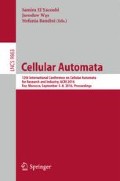Abstract
The calibration and validation of pedestrian dynamics simulation require the acquisition of empirical evidences of human behaviour. In this framework, this paper firstly presents the results of an experimental study focused on the negative impact of counter flow and grouping on pedestrian speed. In particular, we focused on two member groups (dyads) as the most frequently observed and basic interacting element of crowds. On the basis of the behavioural effects observed with the experiment, a novel cellular automaton is proposed to represent the different behaviour of individuals and dyads, with particular reference to the group spatial alignment and the dynamic leader-follower structure. This has been demonstrated to modulate the speed of dyads by maintaining the spatial cohesion among the two members. In addition, the model is also able to reproduce the significant impact of flow ratio observed in the experiment results.
Access this chapter
Tax calculation will be finalised at checkout
Purchases are for personal use only
Notes
- 1.
All the analyses presented in this work have been conducted at the p < .01 level.
References
Bandini, S., Crociani,L., Vizzari, G.: Heterogeneous pedestrian walking speed in discrete simulation models. In: Proceedings of Traffic and Granular Flow 2013. pp. 273–279. Springer International Publishing (2015)
Bandini, S., Gorrini, A., Vizzari, G.: Towards an integrated approach to crowd analysis and crowd synthesis: a case study and first results. Pattern Recogn. Lett. 44, 16–29 (2014)
Blue, V.J., Adler, J.L.: Cellular automata microsimulation for modeling bi-directional pedestrian walkways. Transp. Res. Part B 35(3), 293–312 (2001)
Boltes, M., Seyfried, A.: Collecting pedestrian trajectories. Neurocomputing 100, 127–133 (2013)
Chraibi, M., Seyfried, A., Schadschneider, A.: Generalized centrifugal-force model for pedestrian dynamics. Phys. Rev. E 82(4), 46111 (2010)
Crociani, L., Lämmel, G.: Multidestination pedestrian flows in equilibrium: a cellular automaton-based approach. Comput. Aided Civil Infrastruct. Eng. 31(2016), 432–448 (2016)
Crociani, L., Piazzoni, A., Vizzari, G., Bandini, S.: When reactive agents are not enough: tactical level decisions in pedestrian simulation. Intelligenza Artificiale 9(2), 163–177 (2015)
Duives, D., Daamen, W., Hoogendoorn, S.: Influence of group size and group composition on the adhered distance headway. Transp. Res. Procedia 2, 183–188 (2014)
Gorrini, A., Bandini, S., Vizzari, G.: Empirical investigation on pedestrian crowd dynamics and grouping. In: Proceedings of Traffic and Granular Flow 2013. pp. 83–91. Springer International Publishing (2015)
Helbing, D., Molnar, P.: Social force model for pedestrian dynamics. Phys. Rev. E 51(5), 4282 (1995)
Kirchner, A., Nishinari, K., Schadschneider, A.: Friction effects and clogging in a cellular automaton model for pedestrian dynamics. Phys. Rev. E 67(5), 56122 (2003)
Moussaïd, M., Perozo, N., Garnier, S., Helbing, D., Theraulaz, G.: The walking behaviour of pedestrian social groups and its impact on crowd dynamics. PloS One 5(4), e10047 (2010)
Müller, F., Wohak, O., Schadschneider, A.: Study of influence of groups on evacuation dynamics using a cellular automaton model. Transp. Res. Procedia 2, 168–176 (2014)
Nishinari, K., Kirchner, A., Namazi, A., Schadschneider, A.: Extended floor field CA model for evacuation dynamics. IEICE Trans. Inf. Syst. 87(3), 726–732 (2004)
Nowak, S., Schadschneider, A.: Quantitative analysis of pedestrian counterflow in a cellular automaton model. Phys. Rev. E 85(6), 066128-10 (2012)
Schadschneider, A., Klingsch, W., Klüpfel, H., Kretz, T., Rogsch, C., Seyfried, A.: Evacuation dynamics: empirical results, modeling and applications. In: Meyers, R.A. (ed.) Encyclopedia of Complexity and Systems Science, pp. 3142–3176. Springer, New York (2009)
Shao, W., Terzopoulos, D.: Autonomous pedestrians. Graph. Models 69(5–6), 246–274 (2007)
Suma, Y., Yanagisawa, D., Nishinari, K.: Anticipation effect in pedestrian dynamics: modeling and experiments. Physica A 391(1–2), 248–263 (2012)
Templeton, A., Drury, J., Philippides, A.: From mindless masses to small groups: conceptualizing collective behavior in crowd modeling. Rev. Gen. Psychol. 19, 215–229 (2015)
Was, J., Lubas, R., Mysliwiec, W.: Proxemics in discrete simulation of evacuation. In: Proceedings of the 10th International Conference on Cellular Automata for Research and Industry, ACRI 2012, pp. 768–775 (2012)
Weidmann, U.: Transporttechnik der fussgänger - transporttechnische eigenschaftendes fussgängerverkehrs (literaturstudie). Literature Research 90, Institut füer Verkehrsplanung, Transporttechnik, Strassen- und Eisenbahnbau IVT an der ETH Zürich (1993)
Zanlungo, F., Ikeda, T., Kanda, T.: Potential for the dynamics of pedestrians in a socially interacting group. Phys. Rev. E 89(1), 012811 (2014)
Acknowledgement
The experiment was performed within the authorization of The University of Tokyo. The authors thank Claudio Feliciani, Zhao Pengfei, Barbara Lodigiani, Antonio Menolascina and Prof. Giuseppe Vizzari for their valuable contributions.
Author information
Authors and Affiliations
Corresponding author
Editor information
Editors and Affiliations
Rights and permissions
Copyright information
© 2016 Springer International Publishing Switzerland
About this paper
Cite this paper
Crociani, L., Gorrini, A., Nishinari, K., Bandini, S. (2016). A CA-Based Model of Dyads in Pedestrian Crowds: The Case of Counter Flow. In: El Yacoubi, S., Wąs, J., Bandini, S. (eds) Cellular Automata. ACRI 2016. Lecture Notes in Computer Science(), vol 9863. Springer, Cham. https://doi.org/10.1007/978-3-319-44365-2_35
Download citation
DOI: https://doi.org/10.1007/978-3-319-44365-2_35
Published:
Publisher Name: Springer, Cham
Print ISBN: 978-3-319-44364-5
Online ISBN: 978-3-319-44365-2
eBook Packages: Computer ScienceComputer Science (R0)

